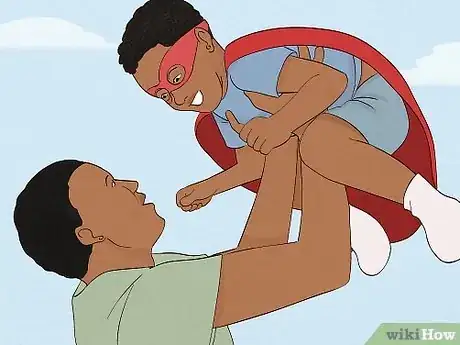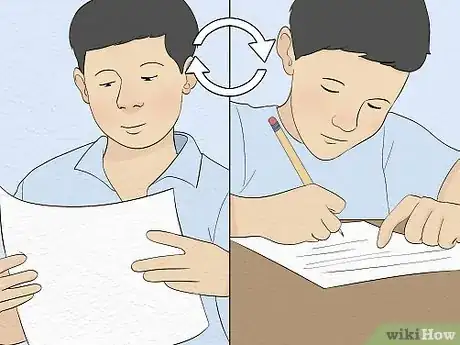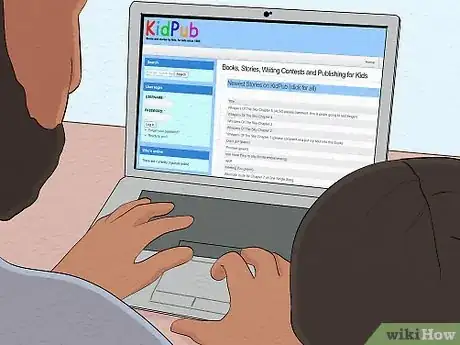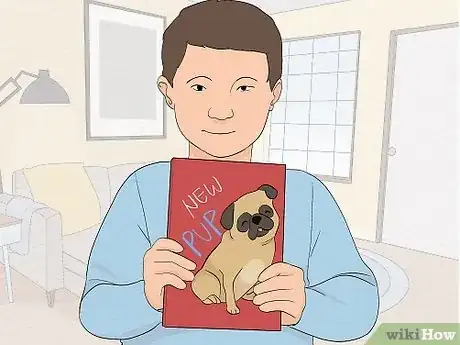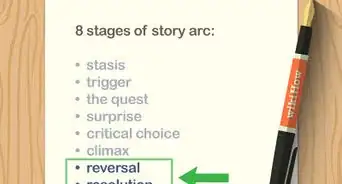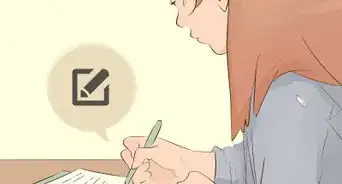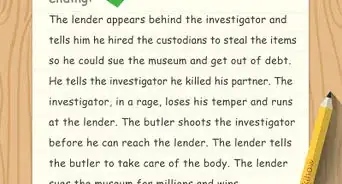This article was co-authored by Grant Faulkner, MA. Grant Faulkner is the Executive Director of National Novel Writing Month (NaNoWriMo) and the co-founder of 100 Word Story, a literary magazine. Grant has published two books on writing and has been published in The New York Times and Writer’s Digest. He co-hosts Write-minded, a weekly podcast on writing and publishing, and has a M.A. in Creative Writing from San Francisco State University.
There are 14 references cited in this article, which can be found at the bottom of the page.
wikiHow marks an article as reader-approved once it receives enough positive feedback. This article received 40 testimonials and 82% of readers who voted found it helpful, earning it our reader-approved status.
This article has been viewed 184,135 times.
If you love to read, chances are you’ve thought about how cool it would be to become an author yourself. Being a kid doesn’t mean you can’t write your own book, and even get it published. From finding your inspiration to getting your book printed, you can do it all. If you work hard and do your best, you can be an author, too!
Steps
Finding Your Inspiration
-
1Read a lot of books. No matter how old you are, if you want to be a great writer, you must be a great reader, too! Read as often and as much as you can. If you aren’t sure what books to read, don’t be afraid to ask your teacher or school librarian for some suggestions.
- Reading is a great way to get a better idea of what sort of writing you actually enjoy reading. When you read new books and find one you really like, take a moment to think about why you like it. What is so great about the story? Does it have really fantastic characters, or setting? Use the things you like in books you read as examples of how to write those things yourself.[1]
- Just like doctors must learn from other doctors, writers must learn from other writers. You might like a specific kind of book, but try to read lots of different kinds of books to learn things from different kinds of writers.
-
2Use your own life as inspiration. It might not seem like anything exciting or interesting happens in your life, but you can still use it as a place to begin your own stories. It can be as easy as taking something that might seem plain or simple, and changing it into something interesting and new.[2]
- For example, if you wanted to write a story about a superhero, use the backdrop of your everyday life to form your new character. Maybe your superhero is a kid just like you, and one day at school, discovers his powers.
- You can also use settings and locations you are familiar with in real life and write a fictional story set in these places. For example, maybe there’s a creepy old house somewhere in your neighborhood. You could write a story about someone who goes into the creepy old house to investigate, and finds something they didn’t expect.
Advertisement -
3Explore your family history for stories and ideas. Ask your mom, dad, grandma, or grandpa to tell you stories about their lives. Learn new things about what life was like when they were kids, and learn about people in your family you don’t know very well, or at all.
- If you are writing fiction (a story that isn’t real or true), you can use stories from your family’s history as a starting point, but change names, places, and details to fit your ideas.[3]
- If you are writing nonfiction (a story that is true), make sure your family knows you are writing about them, and that they feel comfortable sharing their stories and histories for you to write about.
-
4Do some research on people, places, and things you’re interested in. Maybe you studied something in school that really caught your interest, like a historical event, or an interesting person. Use the things you like and are interested in to find ideas for your stories.
- Your hobbies count here, too. For example, if you really like horseback riding, maybe you could write a story about a character who also rides horses. Or, if you like soccer, maybe your main character could be a famous athlete.
- Think of your interests and hobbies, and then do some research on these things for even more inspiration. Use your school’s library, or ask your parents’ permission to do an internet search on the subject.
Writing Your Book
-
1Start with an outline. An outline is a tool for organizing your ideas into chronological order. By making an outline, you will be able to write your book without forgetting any ideas you had for the plot. You will also be able to have a clear idea of what will happen in your book before you write it.
- You can format your outline however you want. Traditionally, you start each section with a shorthand header, and then use bullet points below that header to briefly map out what will happen in that section.
- You can also write separate outlines for different parts of your book. For example, you might have one outline that explains the plot, and have another outline that organizes all the information and ideas you have for your main characters, or even your setting.[4]
-
2Move from your outline to writing your first draft. Once you have your outline written, it should be easier to start writing your actual book. This will just involve taking your shorthand ideas on your outline and expanding them into full chapters and scenes.
- You can try using what is called “The Snowflake Method” which means you start with one sentence—maybe the first sentence of your book, or just of a certain chapter—then work to expand that into a full paragraph, and so on, until you have a large chunk of text.[5]
- The great thing about having an outline prepared is that you can make changes to it as you write and not end up confused or disorganized. So, as you expand your outline into your book, keep tracking your changes on that outline to keep yourself organized.
EXPERT TIPGrant Faulkner is the Executive Director of National Novel Writing Month (NaNoWriMo) and the co-founder of 100 Word Story, a literary magazine. Grant has published two books on writing and has been published in The New York Times and Writer’s Digest. He co-hosts Write-minded, a weekly podcast on writing and publishing, and has a M.A. in Creative Writing from San Francisco State University.Professional Writer
 Grant Faulkner, MA
Grant Faulkner, MA
Professional WriterMotivate yourself with positive self-talk. Like a lot of other endeavors in life, especially creative endeavors, writing a book is largely about telling yourself that you can do it. Don't say, 'Other people are the ones who write books.' Say instead, 'I'm going to be someone who writes a book.' That's one of the basic principles of National Novel Writing Month, where people from all across the country write books in 30 days, — Don't say no to yourself. Say yes, you are a writer, because you write. Whether you're 50, 80, 100, or 13, you can write a book.
-
3Write interesting scenes and dialogue. A very important part of writing a good book is making sure you have a lot of action and dialogue between your characters. A great place to look for an example of good scenes and dialogue is in your favorite books.[6]
- Try not to be too formal with your dialogue. Think about who your characters are—are they kids like you? Grown ups? If they’re kids, think about how you and your friends talk. Think about how your conversations sound. Try to write dialogue that sounds like a real conversation.
- Use action in your scenes. Give your characters something to do. After your main character tells his mom he’s a superhero, does his mom scream? Does she jump around the room in excitement? Let your characters react physically, as well as through words.
-
4Show, don’t tell. When writing your book, you want to try and avoid telling your readers outright every detail of the story. For example, rather than telling the reader that your characters are in a forest, take some time to describe the setting in detail, and let the reader see those characters in a forest.[7]
- Be very descriptive. Rather than writing something that is flat or too simple, try going into detail about the scenes you’re writing. Describe the setting. Describe the way your character looks. Describe the weather, or even the tone of someone’s voice when they speak.
- When writing descriptions, think about your five senses: taste, sight, smell, sound, and touch. What is your character tasting? What does the setting smell and sound like? What can your character feel or see? Use these senses to write interesting, effective descriptions.[8]
Editing and Revising Your Book
-
1Read and edit your first draft. After you’ve written your whole first draft, you will still have a lot of work to do. Start by reading over the whole thing. Read very carefully, and use a highlighter to make a note of anything you want to fix or change.
- Many writers suggest that printing out your work is the best way to edit. So, if you typed your book or story on a computer, print it out and use the paper copy to make your edits.[9]
- Reading your writing out loud will help you notice mistakes you might not see when you read it silently in your head. This is because you will be forcing yourself to read every sentence very carefully.
- Mark any mistakes in spelling and punctuation, and mark any problems you notice with sentences that might not sound right, or places you want to change or fix.
- Make sure your writing is consistent, meaning it stays the same throughout. For example, if you start writing in past tense (“He was”) and then moved to writing in present tense (“He is”), you will want to edit this to stick to one tense throughout.
-
2Polish your final draft. After you’ve gone through once and marked mistakes, fix and change everything you marked in your first draft. Then, go through a second time. Try to wait a few days between each draft to give yourself a set of new eyes the second time through.[10]
- Try focusing on different parts of your book each time you edit. For example, maybe the first edit you focus on the dialogue, while the second edit focuses more on the description or plot.
-
3Decide if you want illustrations in your book. You can choose to do them yourself, or even ask a friend to help! Some authors have illustrations throughout their book, while others have small drawings at the start of each chapter. You can decide to have some illustrations, or none at all.
- If you ask a friend for help in drawing your illustrations, make sure you give your friend credit on the title page!
- Try using different mediums when making your illustrations, should you choose to have them. For example, try drawing some by hand, and then see if creating them on a computer is better.
Publishing Your Book
-
1Use an online publishing service. There are a lot of different ways to publish your book online and then share it with your friends and family. Scribblitt is a tool for kids that allows you to write, illustrate, and design books, as well as have them printed and mailed to you. Some features of this website do cost money, though, so make sure you talk this over with your parents.[11]
- You can also publish your story online and let an online community read and enjoy it. KidPub is a by kids, for kids forum where kids can post their stories and chapter books for each other to read and enjoy.[12]
-
2Have your book printed. Using a service like Scribblitt or LuLu.com, you can have your book professionally bound and printed, for a fee. LuLu will even let you sell copies of your book online. You will need a parent or guardian’s permission and help to access and use these services.
- Keep in mind that any online services might require you to be a certain age to use their services. That’s why it’s important for you to have your parents’ help when using these websites and printing your book.
-
3Send your work to a children’s magazine. There are magazines that specifically publish work by kids, so try sending your story to one of these magazines! Every big author had to start somewhere, and getting your story published in a magazine is a great place to begin.
- Stone Soup is a popular magazine that publishes work by kids, for kids. To get an idea of what kind of stories they like, and for more information on how to submit work to them, pick up a copy from your library, or order a copy from their website. You must be 13 years old or younger to submit work to Stone Soup.[13]
- NewPages.com is a website that helps writers find places to send their work for publication. There is a special part of the website for kids and young writers. Check there for updated and current information on magazines that encourage submissions from young writers.[14]
Community Q&A
-
QuestionHow do you write a really long book?
 Community AnswerYou write with a lot of detail and create minor subplots. If you have already done this and it's still short, look in some of your favorite epic-length books and see what they did.
Community AnswerYou write with a lot of detail and create minor subplots. If you have already done this and it's still short, look in some of your favorite epic-length books and see what they did. -
QuestionHow do I develop the patience that I need to write?
 Community AnswerThe best way is to be interested in what you are writing. If you are interested and excited about the topic or story, the writing will come more naturally to you.
Community AnswerThe best way is to be interested in what you are writing. If you are interested and excited about the topic or story, the writing will come more naturally to you. -
QuestionWho do I ask for an inspiration?
 Community AnswerTalk to someone who is inspiring, caring, and won't judge you if you for wanting to write a book (friend, BFF, maybe even your parents, etc.). Also, read other books in the genre to get inspiration.
Community AnswerTalk to someone who is inspiring, caring, and won't judge you if you for wanting to write a book (friend, BFF, maybe even your parents, etc.). Also, read other books in the genre to get inspiration.
Warnings
- Make sure you have your parents’ permission before you access any websites you aren’t already allowed to view.⧼thumbs_response⧽
- Don’t plagiarize, or steal writing directly from an already published source, like a book or website.⧼thumbs_response⧽
- Avoid any publishing websites that want to charge you money to be published in any kind of anthology or collection.⧼thumbs_response⧽
References
- ↑ http://writetodone.com/how-to-use-reading-to-become-a-better-writer/
- ↑ http://selfpublishingadvice.org/writing-how-to-turn-your-life-into-a-novel/
- ↑ http://www.writersdigest.com/editor-blogs/guide-to-literary-agents/writing-historical-fiction-based-on-a-family-story
- ↑ http://www.writersdigest.com/online-editor/7-steps-to-creating-a-flexible-outline-for-any-story
- ↑ http://www.thecreativepenn.com/2010/01/25/outlining-novel/
- ↑ http://www.writersdigest.com/online-editor/the-7-tools-of-dialogue
- ↑ http://thewritepractice.com/show-dont-tell/
- ↑ https://litreactor.com/columns/writing-powerful-descriptions
- ↑ https://www.themuse.com/advice/5-steps-for-editing-your-own-writing
About This Article
To write a book as a kid, start by making an outline for your story so it's easier to organize all of your ideas. In your outline, include descriptions of all your main characters, the setting for your story, and the plot. Once you have an outline, start working on the first draft of your story. As you're writing, try to be as descriptive as possible by writing about how things look, smell, taste, feel, and sound. If you get stuck, just focus on one sentence at a time and eventually you'll get there! To learn how to get your book published, scroll down!

